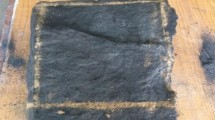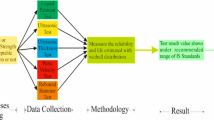Abstract
Introduction
The study employed novel non-destructive testing techniques for coal sample such as resonant column testing, cyclic torsional technique, and ultra-sonic pulse velocity analysis.
Methodology
The study confirms the coal in the present study as bituminous coal by analyzing the microstructure and composition of coal using scanning electron microscope and energy-dispersive X-ray spectroscopy method.
Objective
The damping characteristics (resonant frequency, damping ratio) and dynamic shear modulus of the coal are determined using the resonant column test and the ultrasonic pulse velocity test. Further, numerical simulations using the finite-element method (FEM) in ABAQUS software are performed to obtain resonant frequencies for intact coal samples under torsional and flexural vibrations, and the results of the experimental and numerical studies are found to be in good agreement.
Conclusion
The study has established a critical damping factor range based on the input frequency that can help ensure sustainable design of underground and surface mines.



















Similar content being viewed by others
Data availability
All data generated or analysed during this study are included in this published article.
References
Bhavan I (2020) Government of India Ministry of Mines Indian Bureau of Mines
Ministry of labour and employment G (1952) The Mines Act, 1952. 33
Brnich MJ, Kowalski-Trakofker KM (2010) Underground coal mine disasters 1900–2010: events, responses, and a look to the future. Extr Sci A Century Min Res, pp 363–372
ENVIS Centre on Environmental Problems of Mining (2022) Mining accidents in India. Indian Inst Technol (ISM), Dhanbad
Dash AK (2020) Accident investigation system in Indian mining industry: a case study. J Mines Met Fuels 68:97–102
Wojtecki Ł, Mendecki MJ, Gołda I, Zuberek WM (2020) The seismic source parameters of tremors provoked by long-hole destress blasting executed during the longwall mining of a coal seam under variable stress conditions. Pure Appl Geophys 177:5723–5739. https://doi.org/10.1007/s00024-020-02603-z
Chen B (2020) Stress-induced trend: the clustering feature of coal mine disasters and earthquakes in China. Int J Coal Sci Technol 7:676–692. https://doi.org/10.1007/s40789-020-00334-z
Zhang M, Hu X, Huang H, Chen G, Gao S, Liu C, Tian L (2021) Mechanism and prevention and control of mine earthquake in thick and hard rock strata considering the horizontal stress evolution of stope. Shock Vib. https://doi.org/10.1155/2021/6680928
Hao H, Wu Y, Ma G, Zhou Y (2001) Characteristics of surface ground motions induced by blasts in jointed rock mass. Soil Dyn Earthq Eng 21:85–98. https://doi.org/10.1016/S0267-7261(00)00104-4
Fityus S, Hancock G, Wells T (2008) Geotechnical characteristics of coal mine spoil. Aust Geomech J 43:13–22
Schissler AP (2004) Coal mining, design and methods. Encycl Energy 1:485–494. https://doi.org/10.1016/b0-12-176480-x/00284-9
Sakurovs R, He L, Melnichenko YB, Radlinski AP, Blach T, Lemmel H, Mildner DFR (2012) Pore size distribution and accessible pore size distribution in bituminous coals. Int J Coal Geol 100:51–64. https://doi.org/10.1016/j.coal.2012.06.005
Pan J, Zhao Y, Hou Q, Jin Y (2015) Nanoscale pores in coal related to coal rank and deformation structures. Transp Porous Media 107:543–554. https://doi.org/10.1007/s11242-015-0453-5
Yao Y, Liu D (2012) Comparison of low-field NMR and mercury intrusion porosimetry in characterizing pore size distributions of coals. Fuel 95:152–158. https://doi.org/10.1016/j.fuel.2011.12.039
Tian X, Song D, He X, Liu H, Wang W, Li Z (2021) Investigation of micro-surface potential of coals with different metamorphism by AFM. Meas J Int Meas Confed 172:108915. https://doi.org/10.1016/j.measurement.2020.108915
Zhang Y, Lebedev M, Al-Yaseri A, Yu H, Xu X, Iglauer S (2018) Characterization of nanoscale rockmechanical properties and microstructures of a Chinese sub-bituminous coal. J Nat Gas Sci Eng 52:106–116. https://doi.org/10.1016/j.jngse.2018.01.037
Jiang J, Zhang S, Longhurst P, Yang W, Zheng S (2021) Molecular structure characterization of bituminous coal in Northern China via XRD, Raman and FTIR spectroscopy. Spectrochim Acta Part A Mol Biomol Spectrosc 255:119724. https://doi.org/10.1016/j.saa.2021.119724
Yao SP, Jiao K, Zhang K, Hu WX, Ding H, Li MC, Pei WM (2011) An atomic force microscopy study of coal nanopore structure. Chin Sci Bull 56:2706–2712. https://doi.org/10.1007/s11434-011-4623-8
Neupane B, Ju Y, Huang C (2017) Micro/nano-pore structure characterization of western and central Nepal coals using scanning electron microscopy and gas adsorption. J Nanosci Nanotechnol 17:6836–6842. https://doi.org/10.1166/jnn.2017.14401
Zygarlicke CJ, Steadman EN (1990) Advanced SEM techniques to characterize coal minerals. Scanning Microsc 4:579–590
Gandhi F (2001) Influence of nonlinear viscoelastic material characterization on performance of constrained layer damping treatment. AIAA J 39:924–931. https://doi.org/10.2514/2.1397
Martinez-Agirre M, Elejabarrieta MJ (2011) Dynamic characterization of high damping viscoelastic materials from vibration test data. J Sound Vib 330:3930–3943. https://doi.org/10.1016/j.jsv.2011.03.025
Bert CW (1973) Material damping. J Sound Vib 29:129–153. https://doi.org/10.1016/S0022-460X(73)80131-2
Mog K, Anbazhagan P (2022) Evaluation of the damping ratio of soils in a resonant column using different methods. Soils Found 62:101091. https://doi.org/10.1016/j.sandf.2021.101091
Kokusho T (1981) Cyclic triaxial test of dynamic soil properties for wide strain range. Int J Rock Mech Min Sci Geomech Abstr 18:49. https://doi.org/10.1016/0148-9062(81)91053-6
Vucetic M, Dobry R (1991) Effect of soil plasticity on cyclic response. J Geotech Eng 117:89–107
Darendeli MB (2001) Development of a new family of normalized modulus reduction and material damping curves. Ph D Diss Univ Texas Austin, p 59
Zhang J, Andrus RD, Juang CH (2005) Normalized shear modulus and material damping ratio relationships. J Geotech Geoenvironmental Eng 131:453–464. https://doi.org/10.1061/(asce)1090-0241(2005)131:4(453)
Kokusho T, Aoyagi T, Wakunami A (2005) In situ soil-specific nonlinear properties back-calculated from vertical array records during 1995 Kobe earthquake. J Geotech Geoenvironmental Eng 131:1509–1521. https://doi.org/10.1061/(asce)1090-0241(2005)131:12(1509)
Senetakis K, Anastasiadis A, Pitilakis K (2012) The small-strain shear modulus and damping ratio of quartz and volcanic sands. Geotech Test J 35:20120073. https://doi.org/10.1520/GTJ20120073
Senetakis K, Madhusudhan BN (2015) Dynamics of potential fill-backfill material at very small strains. Soils Found 55:1196–1210. https://doi.org/10.1016/j.sandf.2015.09.019
Sebastian R, Sitharam TG (2018) Resonant column tests and nonlinear elasticity in simulated rocks. Rock Mech Rock Eng 51:155–172. https://doi.org/10.1007/s00603-017-1308-x
Sebastian R, Sitharam TG (2014) Transmission of elastic waves through a frictional boundary. Int J Rock Mech Min Sci 66:84–90. https://doi.org/10.1016/j.ijrmms.2013.12.011
Rohilla S, Sebastian R (2023) Resonant column and cyclic torsional shear tests on Sutlej river sand subjected to the seismicity of Himalayan and Shivalik hill ranges: a case study. Soil Dyn Earthq Eng 166:107766. https://doi.org/10.1016/j.soildyn.2023.107766
Liu Q, Shen YJ, Wu F, Cheng B (2021) Research on the damping mechanisms of composite materials. IOP Conf Ser Earth Environ Sci. https://doi.org/10.1088/1755-1315/702/1/012003
Orban F (2011) Damping of materials and members in structures. J Phys Conf Ser 268:012022. https://doi.org/10.1088/1742-6596/268/1/012022
Ishihara K (1997) Soil behaviour in earthquake geotechnics. Choice Rev Online 34:34–5113. https://doi.org/10.5860/CHOICE.34-5113
Bhat I, Rupali S, Kumar A (2022) Experimental and numerical analysis of constitutive characteristics in bituminous coal. Sādhanā 47:1–17. https://doi.org/10.1007/s12046-022-01911-5
Ilyas B, Rupali S, Arvind K (2022) Evaluation of shear strength parameters in unreinforced and shotcrete reinforced coal through experimental and numerical methods. Disaster Adv 15:10–17. https://doi.org/10.25303/1507da10017
Davarpanah SM, Ván P, Vásárhelyi B (2020) Investigation of the relationship between dynamic and static deformation moduli of rocks. Geomech Geophys Geo-Energy Geo-Resour 6:29. https://doi.org/10.1007/s40948-020-00155-z
Aydin A (2014) Upgraded ISRM suggested method for determining sound velocity by ultrasonic pulse transmission technique. Rock Mech Rock Eng 47:255–259. https://doi.org/10.1007/s00603-013-0454-z
Richart FE, Hall JR, Woods RD (1970) Variations of soils and foundations, 3rd edn. Prentice Hall, New Jersey
Zhang L (2006) Engineering properties of rocks, second. Butterworth-Heinemann is an imprint of Elsevier, University of Arizona Tucson, Arizona
Davarpanah SM, Ván P, Vásárhelyi B (2020) Investigation of the relationship between dynamic and static deformation moduli of rocks. Geomech Geophys Geo-Energy Geo-Resour. https://doi.org/10.1007/s40948-020-00155-z
Stacey FD, Tuck GJ, Moore GI, Holding SC, Goodwin BD, Zhou R (1987) Geophysics and the law of gravity. Rev Mod Phys 59:157–174. https://doi.org/10.1103/RevModPhys.59.157
Ni SH (1987) Dynamic properties of sand under true triaxial stress states from resonant column/torsional shear tests. Ph. D dissertation, The University of Texas at Austin
T.J. Holmquist, G.R. Johnson WHC (1993) A computational consititutive model for concrete subjected to large strains, high strain rates, and high pressures. In: Fourteenth International Symposium on Ballistics Canada, pp 1–10
Johnson GR, Cook WH (1983) A computational constitutive model and data for metals subjected to large strain, high strain rates and high pressures. In: Seventh International Symposium on Ballistics, pp 541–547
Polanco-Loria M, Hopperstad OS, Børvik T, Berstad T (2008) Numerical predictions of ballistic limits for concrete slabs using a modified version of the HJC concrete model. Int J Impact Eng 35:290–303. https://doi.org/10.1016/j.ijimpeng.2007.03.001
Dutt A (2015) Effect of mesh size on finite element analysis of beam. Int J Mech Eng 2:8–10. https://doi.org/10.14445/23488360/ijme-v2i12p102
Barton N (2006) Rock quality, seismic velocity, attenuation and anisotropy, 1st edn. CRC Press
Kuhlemeyer RL, Lysmer J (1973) Finite element method accuracy for wave propagation problems. J Soil Mech Found Div 99:421–427. https://doi.org/10.1061/JSFEAQ.0001885
Deng XF, Zhu JB, Chen SG, Zhao J (2012) Some fundamental issues and verification of 3DEC in modeling wave propagation in jointed rock masses. Rock Mech Rock Eng 45:943–951. https://doi.org/10.1007/s00603-012-0287-1
Acknowledgements
The authors would like to thank Dr. Resmi Sebastian, Assistant Professor, IIT Ropar for allowing them to carry out the Resonant Column Apparatus testing at their facilities. Also, the support of Ms. Sakshi Rohilla, Research scholar at IIT, Ropar in helping to carry out the experimental work is highly acknowledged.
Author information
Authors and Affiliations
Corresponding author
Ethics declarations
Conflict of Interest
The authors declare that there are no conflicts of interest regarding the publication of this article.
Additional information
Publisher's Note
Springer Nature remains neutral with regard to jurisdictional claims in published maps and institutional affiliations.
Rights and permissions
Springer Nature or its licensor (e.g. a society or other partner) holds exclusive rights to this article under a publishing agreement with the author(s) or other rightsholder(s); author self-archiving of the accepted manuscript version of this article is solely governed by the terms of such publishing agreement and applicable law.
About this article
Cite this article
Dogra, A.K., Rupali, S. Evaluation of Material Damping Properties in Bituminous Coal: A Comparative Analysis of Numerical and Experimental Approaches. J. Vib. Eng. Technol. 12, 6197–6214 (2024). https://doi.org/10.1007/s42417-023-01247-2
Received:
Revised:
Accepted:
Published:
Issue Date:
DOI: https://doi.org/10.1007/s42417-023-01247-2




